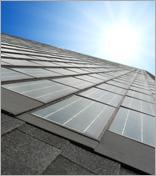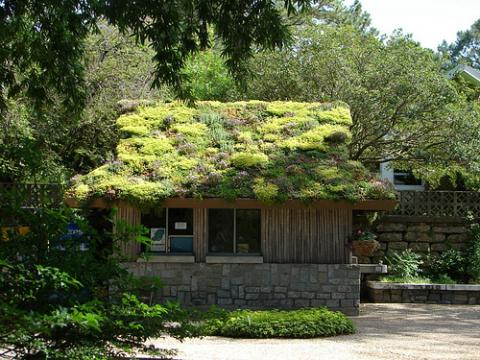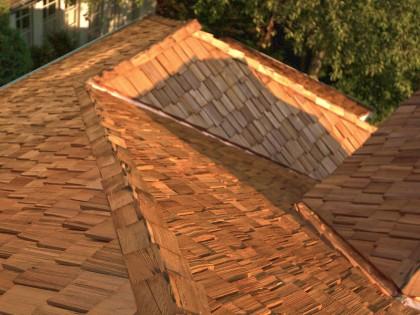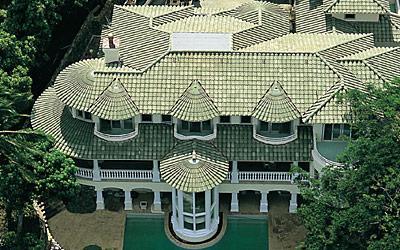The following guest post is written by Chad Janisch, a 10-year roofing industry veteran and owner of the Roofing Annex, a roofing contractor based out of Cincinnati, Ohio. His focus is on blending the traditional grunt work involved in roofing with new technologies that allow for companies to work smarter. He's married and lives in Cincinnati, Ohio with his wife.
-----
We’ve gone green with cars, appliances and technology. Now the movement is on to go green with residential roofing. Environmentally-friendly roofs are gaining in popularity as homeowners recognize the many benefits green roofing brings. With energy bills one of the major expenses of owning a home, eco-friendly roofs are becoming an attractive option for homeowners seeking ways to lower their heating and cooling costs. But more than that, certain types of green roofs are eligible for federal and state tax credits, and deliver benefits beyond just monetary.
When it comes to green roofing, homeowners have their pick from numerous options. Here are 7 of the most popular ways roofs are going green. Each provides unique advantages that not only preserve the environment, but conserve dollars as well.
1. Cool Roof
Looking and feeling cool, a cool roof reflects the sun’s heat away from the roof’s surface. This prevents heat from building up on the roof and transferring down into your home’s interior. Keeping the heat of the sun at bay helps homeowners go green by reducing their use of energy. Not having to use air conditioners or other cooling system as often, homeowners see lower energy bills, too, as much as 7% to 15%, according to the Cool Roof Rating Council.
Cool roofing materials are designed with high values of two green technologies: solar reflectance and thermal emittance. They allow a green roofing system to reflect heat from the sun and cool itself down by emitting thermal radiation from its surface. The California Energy Commission estimates that traditional roofs reach a temperature between 150 and 190 degrees F during summer months while cool roofs register temperatures between 100 to 120 degrees F.
Cool roof technology is available for new home roofs and existing roofs. Cool roof options include highly reflective paints or coatings, reflective tiles or shingles, or a specially designed sheet covering. Shingle manufacturers also are making asphalt shingles with solar reflectance granules.
Installing a cool roof costs the same or even a bit less than traditional roofing systems, giving homeowners yet another reason for going cool on the top of their house. As an incentive for installing a cool roof, several states and municipalities offer rebates, incentive programs, or cool roof loans. To find out what’s offered in your state, visit the Cool Roof Rating Council.
2. Solar Shingles or Panels

Solar roofs are the epitome of a green roof because they reduce our reliance on energy production that harms the environment. Solar panels on roofs collect the heat energy produced by the sun and turn it into electricity to power the home. Some homes are able to go completely off the grid with solar power roofing. Although solar panels have been a green roofing option since the 1950s, new advances in solar technology are now giving homeowners more flexibility in installing a solar roof.
Today’s solar shingles, tiles and panels are less bulky, better looking, more functional and less expensive to install. The latest solar roofing technology is from Dow Chemical. It has introduced the Dow Powerhouse Solar Shingles, a roofing system that combines the protection of a composite roofing shingle with a solar power generation system.
Because it’s a modular design, the number of solar shingles installed can be determined by the homeowner’s budget and energy goals. In addition, solar roofing qualifies for the federal residential energy tax credit and other state, municipal and local utility company tax credits, rebates and reductions.
3. Living Green Roof
The popularity of living green roofs is taking off across the country, as even restaurants now use their building’s roof to grow produce for use in their culinary creations. Living green roofs can be either garden style, known as intensive roofs, or lawn style, the more common type referred to as extensive roofs. In both styles, the roof installation allows for soil and vegetation. A living roof is great for the environment because it is self-sustaining, reduces energy consumption, lowers greenhouse gas emissions and requires very little roof maintenance.
Although around for centuries throughout Europe, vegetated roofs in the U.S. are now growing strong, as homeowners enjoy their affordability, the fruits of their labor and the green advantages. Green roofs range in cost from $22 per square foot to $100 per square foot for an elaborate garden style on a large home. Although they may cost more to install and require structural reinforcements, those initial costs are recouped over the years. A green roof saves on roof maintenance costs because the vegetation serves as a barrier against the sun’s rays and the damage it causes to roofing materials. In addition, a living green roof also reduces a home’s heating and cooling costs because it acts as insulation during the winter and a cool roof during the summer.
4. Rainwater Harvesting System
When it comes to conserving water, a roof is the catalyst for collecting rainwater or melting snow water and channeling it through a home’s gutter and downspout system into some sort of wood, metal, or plastic container covered by a screen for blocking debris. This type of setup gives homeowners the advantage of conserving water and lowering their water bills while reducing watershed pollution and the demand on local water supplies.
The safest types of roofs for installing a rainwater system are tile, slate and certain metal roofing. This ensures there are no toxins or pollutants coming off the roofing material and into the water.
For most homes, rain barrels suffice for collecting roof water. You can find them in hardware stores, or Green America gives step-by-step directions for building your own rain barrel. Depending on how much rainwater you want to collect, there are more sophisticated rain harvesting systems that include underground tanks with pumps to supply water to landscapes and gardens.
Collected rainwater also can be used for washing clothes, watering the garden, washing the family vehicles, or to flush toilets. It’s particularly useful during droughts when municipalities institute mandatory water restrictions.
5. Sustainable Roofing

A sustainable roof is made from either repurposed materials or a renewable source. It delivers energy efficiency and other green benefits, and can be recycled after its lifecycle expires. Wood roofing, like cedar shakes and shingles, ceramic roof tiles, metal roofing, composite or synthetic roofing, reflective roofing, polymer roofs and photovoltaic panel system roofing are all examples of sustainable roofing.
Besides preserving the environment, sustainable roofs give homeowners some significant cost-saving advantages. In energy savings alone, the Center for Environmental Innovation in Roofing determined that sustainable roofing could save over 700 trillion BTUs each year.
Sustainable roofing materials also last longer because they resist UV damage and weathering. Their long-term performance reduces roof replacement costs.
6. Durable Roofing

Durable roofing is made to last a lifetime, thus saving homeowners the cost of roof replacement and preserving the environment by reducing landfill waste. As an added bonus, most durable roofing materials are energy efficient, saving homeowners money on their utility bills.
Slate tiles are the most durable type of roofing, lasting 100 or more years. Other durable roofing materials include fiber-cement shingles, metal roofs, concrete tiles, clay tiles, and wood shingles and shakes. Another option is premium-grade asphalt shingles, which are built to last for 50 years.
Climate is key when selecting a durable roof. For example, clay and concrete tiles may not be best in climates that experience hailstorms because they can crack. Although durable roofs are long-lasting, they require minimal roof maintenance from time to time.
Mapawatt has a nice post on the advantages of a metal roof.
7. Energy Efficient Roofs
The initial investment may be more, but energy efficient roofing delivers long-term cost savings. Roofs that are energy efficient are discernible by the Energy Star label, a program developed by the U.S. Department of Energy and the U.S. Environmental Protection Agency to help consumers save money while protecting the environment by using energy efficient products.
Energy Star approved roofs include metal roofing, asphalt shingles, reflective roofing, clay tiles and green roofs.
Homeowners realize significant savings in their energy bills each year. As an added bonus, homeowners who install energy efficient roofing may also qualify for a federal residential energy tax credit.
As the roofing industry continues to move towards more eco-friendly products, the green movement is a winner for both the environment and homeowners. For those interested in going green with their roofs or applying energy efficient techniques to an existing roof, a reputable roofing contractor who is up-to-date on all the latest green technologies for roofing is a valuable resource.



Post new comment